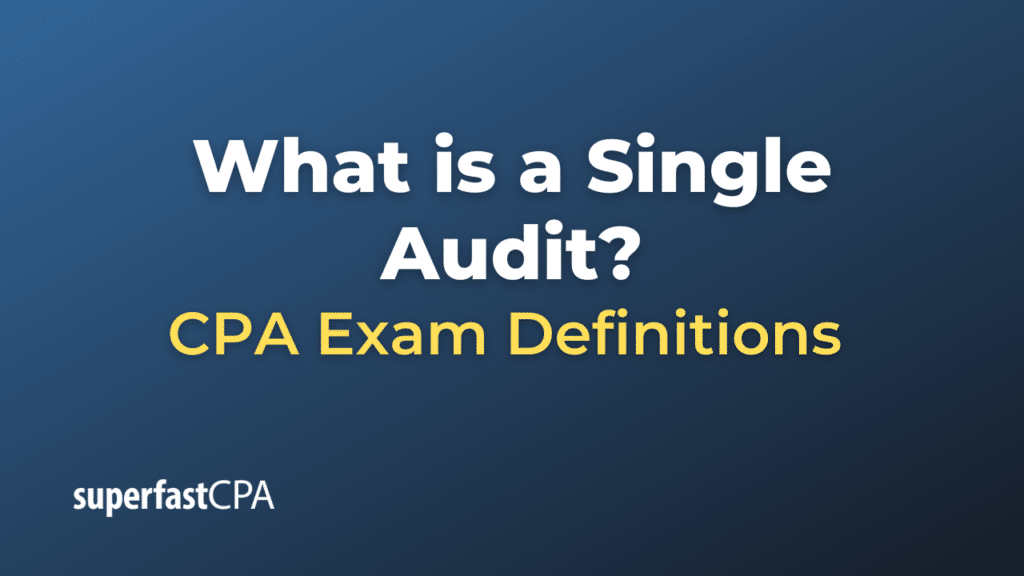Single Audit
A Single Audit, often known as an “OMB Uniform Guidance audit” in the United States, refers to an audit that encompasses both financial statements and federal awards expended by non-federal entities that receive federal funding. The primary goal of this type of audit is to ensure that the federal funds are used for their specified purposes and that the receiving entities comply with the associated federal regulations and requirements.
The Single Audit is required for state and local governments, non-profit organizations, and certain for-profit organizations that expend $750,000 or more in federal assistance in a single year. The threshold may change over time, so it’s essential to refer to the most current guidelines.
The audit’s basis is the U.S. Office of Management and Budget (OMB) Uniform Administrative Requirements, Cost Principles, and Audit Requirements for Federal Awards, often referred to as “Uniform Guidance.
Key aspects of the Single Audit include:
- Financial Statement Audit: Evaluates the accuracy and fairness of the entity’s financial statements.
- Internal Control Review: Assesses the internal control structure related to federal award programs.
- Compliance Audit: Examines the entity’s compliance with federal statutes, regulations, and terms and conditions of federal awards.
The Single Audit culminates in a package of reports, which generally includes:
- Financial statements and schedule of expenditures of federal awards.
- Auditor’s reports on the financial statements, internal controls, and compliance.
- A schedule of findings and questioned costs.
- A corrective action plan provided by the audited entity in response to any findings.
After completion, the Single Audit reports are submitted to the Federal Audit Clearinghouse, making them accessible to all federal agencies.
In essence, the Single Audit provides assurance to the federal government that its funds are being spent appropriately and that recipients of these funds have the necessary internal controls in place to manage and report on their use.
Example of a Single Audit
Let’s illustrate the concept of a Single Audit with a hypothetical scenario:
Scenario: City of GreenVale and a Federal Grant
The City of GreenVale has been awarded a federal grant of $2 million to enhance its public transportation system. This grant is intended to support the purchase of eco-friendly buses, build new bus stops, and improve accessibility for all residents.
By the end of the fiscal year, GreenVale has expended $1.5 million of the federal grant.
Given that the city has expended more than the threshold of $750,000 in federal funds in a single year, it is required to undergo a Single Audit.
- Financial Statement Audit: The auditors review GreenVale’s financial statements, ensuring they accurately represent the city’s financial position, and specifically, the expenditure related to the federal grant.
- Internal Control Review: Auditors assess whether GreenVale has robust internal controls in place to manage the grant funds. They evaluate procedures like how funds are disbursed, how purchases are approved, and how funds are tracked and reported.
- Compliance Audit: The audit team examines GreenVale’s adherence to the specific requirements of the federal grant. They check if the funds were only used for the intended purposes (like purchasing eco-friendly buses) and if the city met any matching fund requirements or other conditions specified in the grant.
Audit Findings:
During the audit, the team discovers that $50,000 of the grant was used to repair roads, which was not an approved use of the funds according to the grant’s terms. This becomes a key finding in the Single Audit report.
Outcome:
Upon completion, the auditors compile their findings and recommendations in the Single Audit report. GreenVale’s management provides a corrective action plan, detailing how they will address the misallocation of funds and prevent similar occurrences in the future.
The Single Audit report, along with GreenVale’s corrective action plan, is then submitted to the Federal Audit Clearinghouse.
This example illustrates how a Single Audit works for entities that receive and expend federal funds, ensuring compliance, accountability, and proper utilization of those funds.













